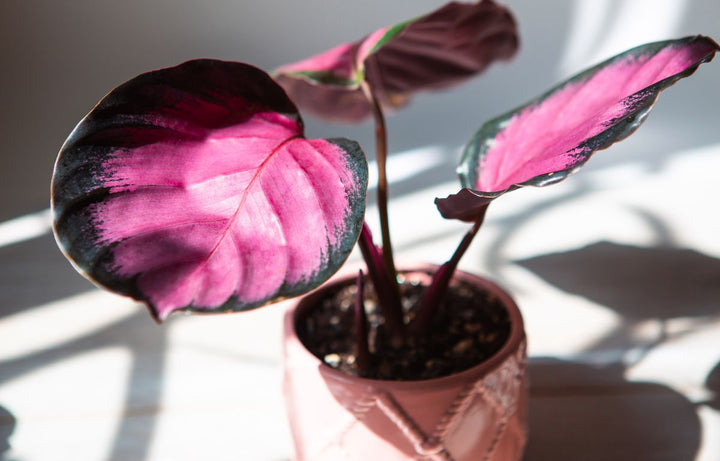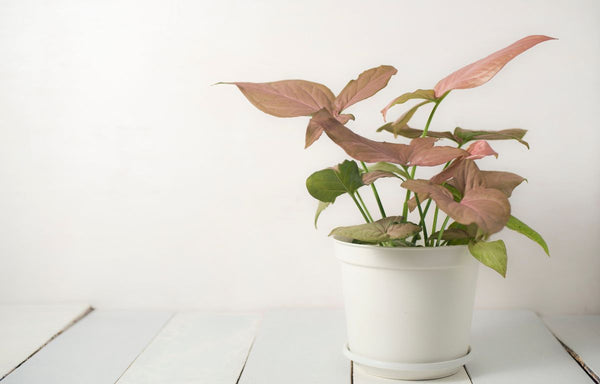
Embracing Pink Elegance: Pink Variegated Houseplants
Embracing Pink Elegance: Pink Variegated Houseplants
Pink variegated houseplants have become beloved for their whimsical charm and vibrant hues, offering a refreshing departure from traditional greens in indoor spaces. Beyond their aesthetic appeal, the allure lies in the uniqueness of each plant's variegated patterning. The intricate blend of pinks, whites, and greens on the foliage creates individuality, making these plants not only visually striking but also uniquely one-of-a-kind additions to a diverse and lush houseplant collection.

Syngonium podophyllum 'Pink Syngonium'
Why Are They Pink?
The mesmerizing pink hues in variegated houseplants are a result of a genetic mutation affecting pigmentation. Variegation occurs when there is a mix of pigmented (coloured) and non-pigmented (white or light-coloured) cells in the plant's tissues. The presence of pink in variegated plants is often attributed to anthocyanins, a group of pigments responsible for red, purple, and blue colours in plants.
However, the appearance of variegation can also be influenced by factors such as light intensity, temperature, and overall plant health.
Variegated Houseplants
There are several types of houseplants that exhibit pink variegated patterning, and they come in various shapes and sizes. Here are just a handful of them:
Pink Princess Philodendron (Philodendron erubescens): This stunning plant features dark green and pink variegated leaves. The intensity of the pink colour can vary based on the plant's age and growing conditions.
Pink Syngonium (Syngonium podophyllum): Also known as the Arrowhead Plant, Pink Syngonium displays arrow-shaped leaves with pink variegation. It starts with shades of light pink and develops deeper hues as the plant matures.
Caladiums (Caladium spp.): These tropical plants are known for their large, heart-shaped leaves with intricate pink variegation. Caladium varieties like ‘pink symphony’, 'Pink Beauty' and 'Miss Muffet' showcase beautiful pink patterns.
Nerve Plant (Fittonia spp.): Fittonias, or Nerve Plants, are known for their bold veined patterns. Some varieties, like the 'Pink Star' or 'Pink Angel,' feature pink variegation on vibrant green leaves.
Begonia Rex (Begonia rex-cultorum): Begonia Rex varieties often have striking foliage with intricate patterns, including pink variegation. 'Escargot' and 'Pink Teardrops' are examples of Rex Begonias with pink accents.
Tradescantia tricolour (Tradescantia spp.): Also known as Wandering Jew, some Tradescantia varieties, such as 'Pink Stripe' or 'Tricolour,' exhibit pink stripes or patches on their leaves.
Hoya Kerrii 'Variegata': Commonly known as the Sweetheart Plant, Hoya Kerrii 'Variegata' is a succulent with heart-shaped leaves that have pink variegation along the edges.
Peperomia 'Rosso': The Peperomia 'Rosso' variety is known for its vibrant green and pink leaves, creating a visually appealing contrast. It is a compact and easy-to-care-for houseplant.
Pink Jelly Bean (Sedum Rubrotinctum Aurora): This charming succulent is commonly referred to as "Pork and Beans" or "Jelly Bean Plant" due to the shape and colour of its plump, bead-like leaves.
Rose Painted Calathea (Calathea Roseopicta Rosy): The Rose Painted Calathea, scientifically known as Calathea roseopicta 'Rosy,' has stunning shades of green, pink, and burgundy, creating a captivating rosy brush stroke or marbled effect.

Caladiums (Caladium spp.) 'Pink Beauty'
Pros and Cons of Variegated Plants:
Pros:
Aesthetic Appeal: Variegated plants, with their unique patterns and colours, enhance the visual appeal of indoor spaces, creating a lively and vibrant atmosphere.
Versatility: Pink variegated plants come in various species and sizes, offering a wide range of options to suit different preferences and interior designs.
Air Purification: Like their non-variegated counterparts, these plants contribute to air purification by absorbing pollutants and releasing oxygen.
Cons:
Sun Sensitivity: Variegated plants, particularly those with pink colouring, may be more sensitive to direct sunlight. Prolonged exposure can lead to sunburn, causing damage to the leaves.
Slower Growth: Variegation can slow down a plant's growth rate, as the non-pigmented areas lack chlorophyll, hindering photosynthesis.
Cost of Pink Variegated Houseplants:
The cost of pink variegated houseplants can vary based on factors such as species, size, and rarity. Common varieties may be more budget-friendly, while rare or highly sought-after specimens can command higher prices. On average, you can find small to medium-sized pink variegated houseplants like Fittonia and Calathea varieties for around $20 to $50 AUD. However, prices can go higher for larger or more unique specimens like the Philodendron Pink Princess which can range anywhere from $100-1000 AUD depending on the number of leaves and variegated patterning.

Philodendron erubescens 'Pink Princess'
Caring for Pink Variegated Houseplants:
Light: Place your pink variegated plants in bright, indirect light to maintain their vibrant colouring. Shield them from harsh afternoon sunlight to prevent sunburn.
Watering: Maintain a consistent watering schedule, allowing the top inch of the soil to dry between waterings. Overwatering can lead to root rot, while underwatering may stress the plant.
Humidity: Many variegated plants thrive in higher humidity levels. Mist the leaves regularly or place a humidity tray near the plant to create a more favourable environment.
Soil: Use well-draining soil to prevent waterlogging, as excess moisture can be detrimental to the plant's health.
Fertilization: Feed your pink variegated plants with a balanced liquid fertilizer during the growing season (spring and summer) to support healthy growth.
Pruning: Trim any yellow or non-variegated leaves to encourage the plant to focus energy on producing vibrant, pink foliage.
Although it might seem terrible, it can be beneficial to remove overly variegated leaves when the plant is still young. This increases the rate of growth but reduces the immediate appeal of the plant.
Pink variegated houseplants are a delightful addition to any indoor space, bringing a splash of colour and elegance. However, they do require a bit more care and vigilance than most green foliage houseplants. Understanding the reasons behind their pink hues, weighing the pros and cons, and following proper care guidelines will ensure that these plants thrive and continue to captivate with their enchanting colouring.
Interested in learning more? Check out our blog post on the Peace Lily.
